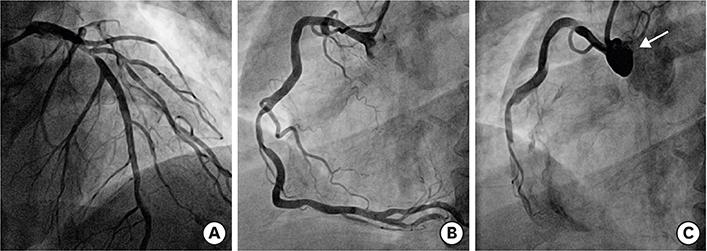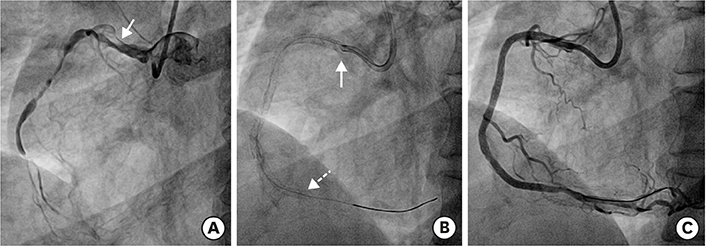Korean Circ J.
2019 Apr;49(4):363-365. 10.4070/kcj.2018.0284.
Computerized Tomography is an Effective Modality to Evaluate Iatrogenic Aortocoronary Dissection with Acute Myocardial Infarction
- Affiliations
-
- 1Department of Thoracic and Cardiovascular Surgery, Gil Medical Center, Gachon Cardiovascular Research Institute, Gachon University College of Medicine, Incheon, Korea.
- 2Cardiology Division, Department of Internal Medicine, Gil Medical Center, Gachon Cardiovascular Research Institute, Gachon University College of Medicine, Incheon, Korea. likemed@gilhospital.com
- KMID: 2441141
- DOI: http://doi.org/10.4070/kcj.2018.0284
Abstract
- No abstract available.
MeSH Terms
Figure
Reference
-
1. Dahdouh Z, Roule V, Lognoné T, et al. Iatrogenic bidirectional dissection of the right coronary artery and the ascending aorta: the worst nightmare for an interventional cardiologist. Korean Circ J. 2012; 42:504–506.
Article2. Dunning DW, Kahn JK, Hawkins ET, O'Neill WW. Iatrogenic coronary artery dissections extending into and involving the aortic root. Catheter Cardiovasc Interv. 2000; 51:387–393.
Article3. Li L, Cao Y. Extensive dissection to the coronary sinus of Valsalva during percutaneous intervention in right coronary artery—a case report and literature review. Clin Med Insights Cardiol. 2011; 5:41–44.
Article4. Celik M, Yuksel UC, Yalcinkaya E, Gokoglan Y, Iyisoy A. Conservative treatment of iatrogenic left main coronary artery dissection: report of two cases. Cardiovasc Diagn Ther. 2013; 3:244–246.5. Shorrock D, Michael TT, Patel V, et al. Frequency and outcomes of aortocoronary dissection during percutaneous coronary intervention of chronic total occlusions: a case series and systematic review of the literature. Catheter Cardiovasc Interv. 2014; 84:670–675.
- Full Text Links
- Actions
-
Cited
- CITED
-
- Close
- Share
- Similar articles
-
- Acute Myocardial Infarction in Patient with Spontaneous Coronary
- A Case of Acute Myocardial Infarction Occurred Immediately after Endoscopic Submucosal Dissection
- Invasive Treatment of Acute Myocardial Infarction: What is the Optimal Therapy for Acute Myocardial Infarction?
- A Case of Acute Aortic Dissection Involved Left and Right Coronary Arterial Ostia diagnosed with Transesophageal Echocardiography
- Acute Closure of Target and Remote Coronary Arteries Complicated by Balloon Rupture during Primary Stenting of Acute Myocardial Infarction





